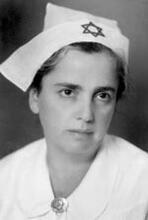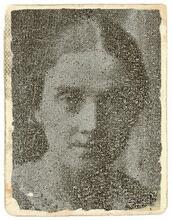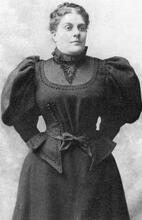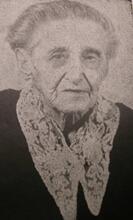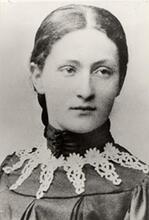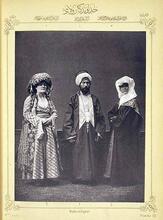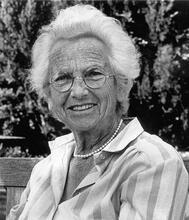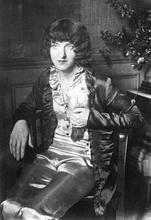Lina Solomonovna Stern (Shtern)
Lina Stern with other members of the Jewish Anti-Fascist Committee set up by the Soviet government in WWII. L to R: Itzik Fefer, Samuel Halkin, Solomon Mikhoels, Ben-Zion Goldberg (non-member visiting from the U.S.), Lina Stern, General Aaron Katz and Peretz Markish.
Courtesy of Ben-Zion Goldberg, New York
Lina Shtern was a path-breaking biochemist known for her work on the blood-brain barrier. She was the first woman professor at the University of Geneva and the first woman named to the Soviet Academy of Sciences. Born in Latvia, she moved to the USSR out of political idealism. An active member of the Jewish Anti-Fascist Committee during World War II, Shtern fell victim to two separate postwar repressions, one targeting biologists and the other targeting Jews. At the secret trial of the Jewish Anti-Fascist Committee, she behaved with uncommon valor. She was that trial’s sole survivor.
The physiologist and biochemist Lina Solomonovna Shtern was the first woman professor at the University of Geneva, the director of several important laboratories in the Soviet Union, and ultimately the sole defendant at the 1952 secret trial of the Jewish Anti-Fascist Committee to be spared execution. Shtern’s behavior at that trial revealed her extraordinary courage in the face of death.
Family and Education
Shtern was born on August 26, 1878, in what is now Latvia, then a part of the Russian Empire. Her parents were well-off; her hometown of Liepaja was not part of the Pale of Settlement to which most Russian Jews were confined before February 1917. She was the eldest of seven children. Her brother Bruno Shtern became a businessman like their father. In the post-war years, Bruno, who lived in the west, would supply his Soviet sister with the hard-to-obtain new antibiotic streptomycin she needed for her research. Soviet security services tolerated the contact because they wanted the streptomycin, though ever wary of foreign connections, they kept records in anticipation of Lina’s arrest.
In Liepaja, Lina was a brilliant student. Her gimnasia education, as well her German-speaking family, accounts for her multilingualism: in addition to German, she was at home in French and Russian, which she spoke with an accent. Still, as both a woman and a Jew, she could not gain admittance to a Russian university. Like many young people in her position, she went to the University of Geneva and, while still a student, began working under the physiologist Jean-Louis Prevost. She became a Doctor of Medicine in 1903 and returned home with the intention of working locally. An invitation from Prevost derailed that path, and she went back to Switzerland.
Early Career
Shtern went on to work with Frederic Battelli, ten years her senior. Between 1904 and 1922, Battelli and Shtern published 54 articles on cellular metabolism (Vein). Their work was a significant element in establishing what later became known as the Krebs or citric acid cycle, the series of chemical reactions involved in cell respiration. In 1918, she became a professor in the newly established Department of Physiology at the University of Geneva.
Geneva was a hotbed of Russian revolutionaries. The Marxist theorist Georgii Plekhanov lived there for most of his adult life, beginning in 1880. Stern spent some time living at a boarding house run by Plekhanov’s family, where she became close to his wife and daughters. An ultimately more important figure in her life was Aleksei Bakh. In addition to his activities as a biochemist with a focus on cell respiration, Bakh, a baptized Jew, was an alumnus of the Russian radical movement. Both men returned to Russia in 1917. Plekhanov left again soon after the Bolsheviks took over, but Bakh stayed, thrived, and ultimately invited Shtern to join him as head of the Physiology Department at the Second Moscow University.
Work and Politics in the Soviet Union
In Geneva, Shtern was working productively; she had money and a social circle. Why did she go to the Soviet Union at age 48? Iakov Rapoport, a later colleague and close friend, described her move as impulsive, a product of adventurism and naiveté. Most of Shtern’s colleagues in Geneva were horrified and tried to dissuade her. They kept her position and an apartment open for her for five years. She wasn’t tempted—a fact that she would relate at the trial as evidence of her Soviet loyalty.
Shtern arrived in the USSR in 1925, on a day she would celebrate throughout her life as a second birthday. She exulted, her student Boris Malkin later said, in the fact that Soviet citizens addressed each other as comrade (an extraordinarily naïve take). In addition to her scientific articles (49 in her first three years in the USSR), she wrote, or more likely signed, political essays intended for a general audience. In 1938, in the middle of the Terror (the period of mass arrests and executions that targeted the intelligentsia as well as other groups, including the Party), she became a member of the Party. It had taken her eight years of trying.
Despite some obstacles—she did not, for example, get along with Ivan Pavlov, the dean of Russian physiology—Shtern’s scientific productivity was formidable. In addition to chairing the Department of Physiology, she organized two laboratories, in the Mechnikov Medical-Biological Institute and the Institute for Infectious Diseases. When the Second Moscow University was reorganized into separate institutes, she became the head of its Institute for Physiology. Her work focused on the blood-brain barrier, a term, still used, that she introduced, and connected the introduction of therapeutic agents into the spinal fluid (Vein). In 1934, she became a Distinguished Scientist of the Russian Republic. In 1939, she became a Full Member of the Academy of Sciences, the first woman to attain that position.
Jewish Anti-Fascist Committee
At the beginning of 1942, when the Soviet Union, overrun by Nazis, was in perilous shape, Stalin created five “Anti-Fascist committees” intended to generate enthusiasm and financial support in the West. Shtern, because of her international reputation, was attached to three of them (Women, Scientists, and Jews). The latter connection proved fateful.
While Shtern had never been particularly interested in Jews as a group, the war changed her attitude. Her participation in the Jewish Anti-Fascist Committee was far from perfunctory; she played an active role in meetings and suggested forming Jewish brigades to fight at the front. But the middle years of the war also saw the rise of Soviet state antisemitism, which had not been a factor earlier. Shtern learned that Jews were being fired from scientific institutes and from the editorial boards of scientific journals. Never shy, she wrote directly to Stalin. Her power was her international reputation, and she leveraged it. In the short term, she won: her staff was not fired, and she herself received a Stalin Prize.
Attacks and Trial
Between the end of the war and his death in 1953, Stalin cracked down on three groups: artists (including writers and composers), Jews, and certain types of scientists, most prominently geneticists. Shtern fell into two of those groups: while she was not a geneticist, biochemist proved close enough. Another factor may have been streptomycin: at one point Stalin’s daughter asked for some, and the uncompromising Shtern turned her down.
The first public attack on Shtern was an article published in the summer of 1947 in a subpar medical journal. The fact that the author had earlier praised Stern effusively leaves little doubt that the attack was orchestrated. A year later, a prestigious medical publisher issued a small book entitled Protif uproshchenchestva i uproshchentsev (Against Reductionism and Reductionists) by the same author. Shtern’s lab was taken away and all its equipment given to a researcher in another institution in a different city. A little later, at a now-famous conference targeting geneticists, Shtern spoke in her own defense. As Soviet conferences were highly scripted, her spontaneity was courageous and unusual.
The members of the Jewish Anti-Fascist Committee were arrested in 1948 and 1949. Shtern, a woman of 71, was subjected to interrogations that sometimes lasted 24 hours. Her cellmates made her wash the floors and carry out the toilet pail. At interrogation, she was called an old whore and accused of prostituting herself while at conferences abroad. She responded, in typical fashion, that at her age she would be the one who had to pay for sex. She was also sent to the punishment cells of Moscow’s infamous Lefortovo Prison, where she started hallucinating.
The Jewish Anti-Fascist Committee trial was secret, but the transcripts survived and have been published. A few of the other victims went off-script in their own defense, notably Dr. Boris Shimeliovich, the head of Moscow’s Botkin Hospital, and Solomon Lozovsky, the high-ranking political figure who headed the committee. Shtern was called to testify last: the organizers were afraid of her. At one point, the chief judge (there were no lawyers) asked her to stop lecturing him.
Defendants were supposed to confess their guilt. Shtern’s opening statement defied that plan. “Sitting here at court,” she said, “I have come to the conclusion that I can’t accuse myself because even if I had looked closely at everything I wouldn’t have understood the whole criminality of it and therefore nothing would have changed. I also think that these volumes [the 42 volumes of defendants’ testimony, obtained through torture or the threat of torture] contain a lot more than actually happened”(Naumov). In other words, either there were crimes but she was too incompetent to understand them, or far more likely, there were no crimes at all and the testimony was coerced.
The fate of the accused had been decided in advance, as most of them suspected. Thirteen defendants, two of them women, were shot on August 13, 1952. (Since many were writers, the date is often commemorated as The Night of the Murdered Poets.) Stern was sent to exile in Jambyl, Kazakhstan.
Return to Moscow
Returning to Moscow after Stalin’s death in 1953, Shtern spent some days with the family of Iakov Rapoport, himself a victim of the antisemitic Doctors’ Plot. Rapoport wrote down what Shtern told him. The story of her scientific work and her ordeal under arrest ends here. The de-Stalinization that dominated the next decades of Soviet life were restorative for Shtern, who was able to resume the life of the Soviet elite: car, driver, servant. She did not speak about what happened to her, either publicly, or (aside from the one instance with the Rapoports) privately. Her laboratory was restored to her, and she continued work on the blood-brain barrier, which culminated in three international conferences that she organized (Malkin).
She died on March 7, 1968, a path-breaking scientist and a woman of extraordinary courage.
Malkin, Viktor Borisovich. “Trudnye gody Liny Shtern” (The Difficult Years of Lina Shtern). In “Tragicheskie sud'by: repressirovannye uchenye Akademii nauk SSSR” (Tragic Fates: the repressed scientists of the USSR Academy of Sciences). Arkhiv russkii akademii meditsinskikh nauk, f. 9120 op. 8/2, 1966.
Nakhimovsky, Alice. “Assessing Life in the Face of Death: Moral Drama at the 1952 trial of the Jewish Anti-Fascist Committee.” East European Jewish Affairs 48 no.2 (2018): 188-209.
Naumov, V. P. Nepravednyi sud: poslednii Stalinskii rasstrel (A Trial Without Justice: Stalin’s Final Execution). Moscow: Nauka, 1994.
Rapoport, Iakov. Na rubezhe dvukh epokh: delo vrachei 1953 goda. (On the Border of Two Centuries: The Doctors Plot), Moscow: Kniga, 1988.
Redlikh, Shimon and Gennadii Kostyrchenko, eds. Evreiskii Antifashistskii Komitet v SSSR 1941-1948: documental’naia istroiia. (The Jewish Anti-Fascist Committee in the USSR: a documentary history). Moscow: Mezhdunarodnye otnosheniia, 1996.
Rubenstein, Joshua and Vladimir Namov. Stalin’s Secret Pogrom, the postwar inquisition of the Jewish Anti-Fascist Committee. New Haven: Yale, 2001.
Vein, Alla A. “Science and Fate: Lina Shtern (1869-1968), a Neurophysiologist and Biochemist.” Journal of the History of the Neurosciences 17 (2008): 195-206.


